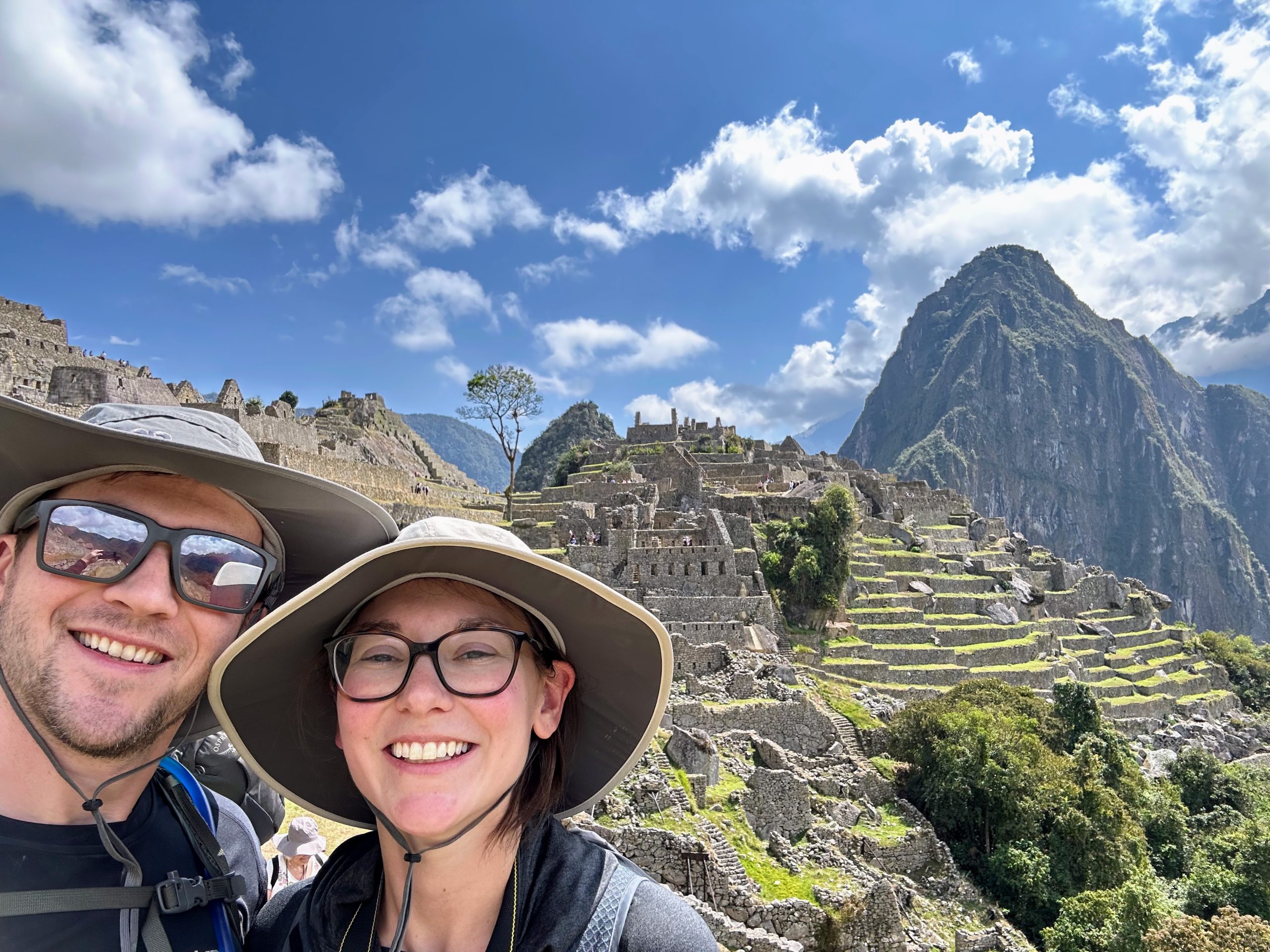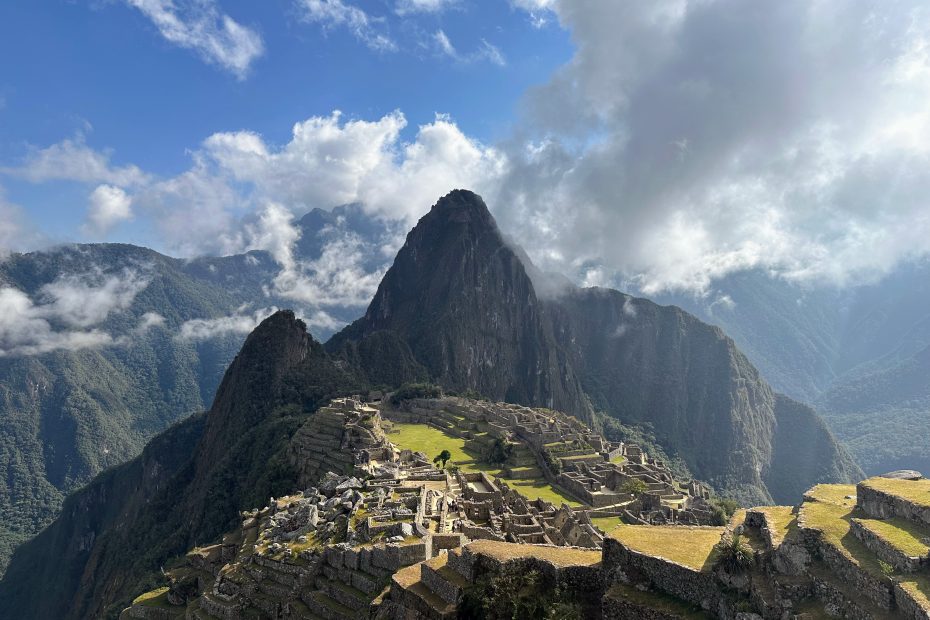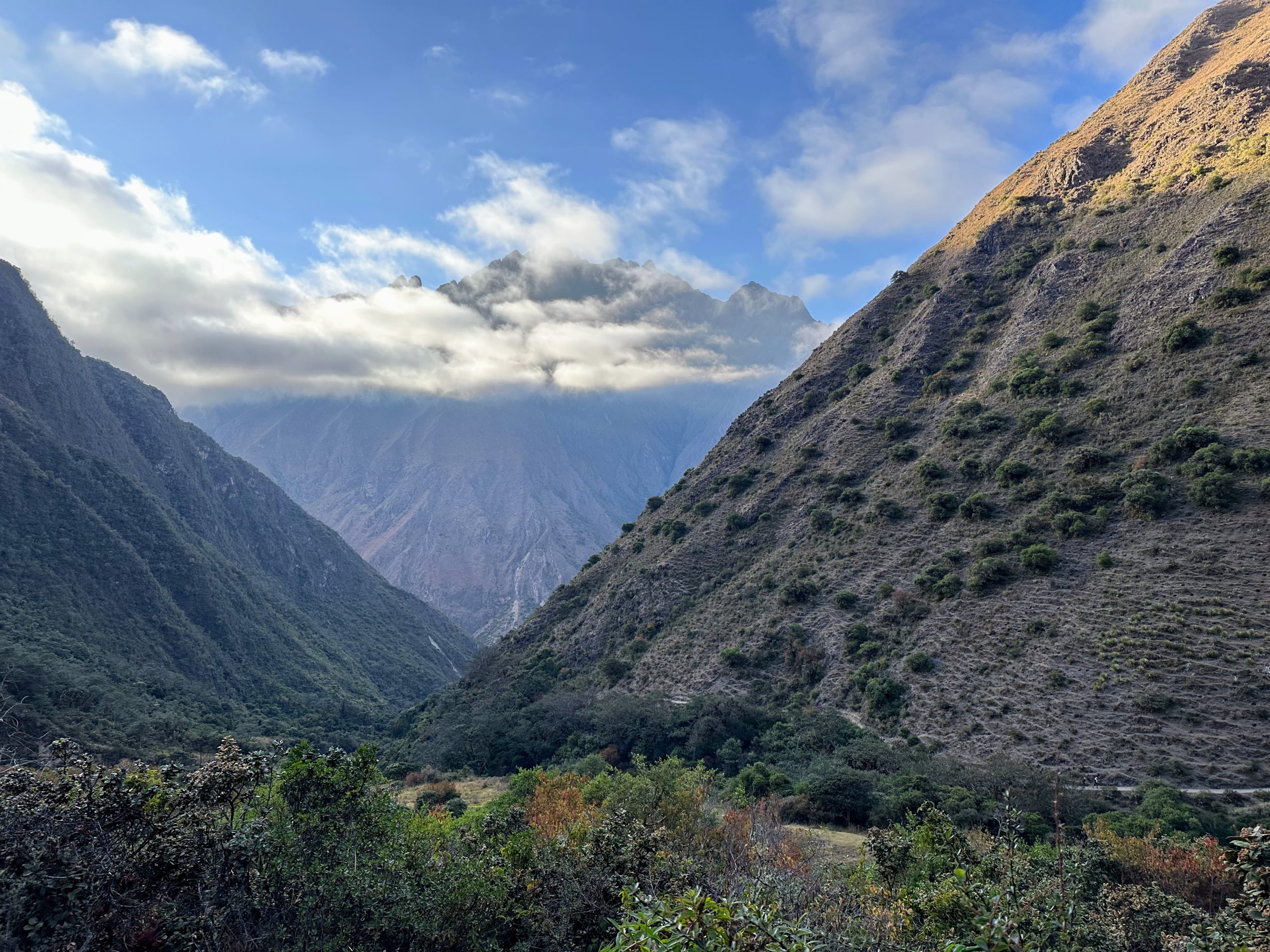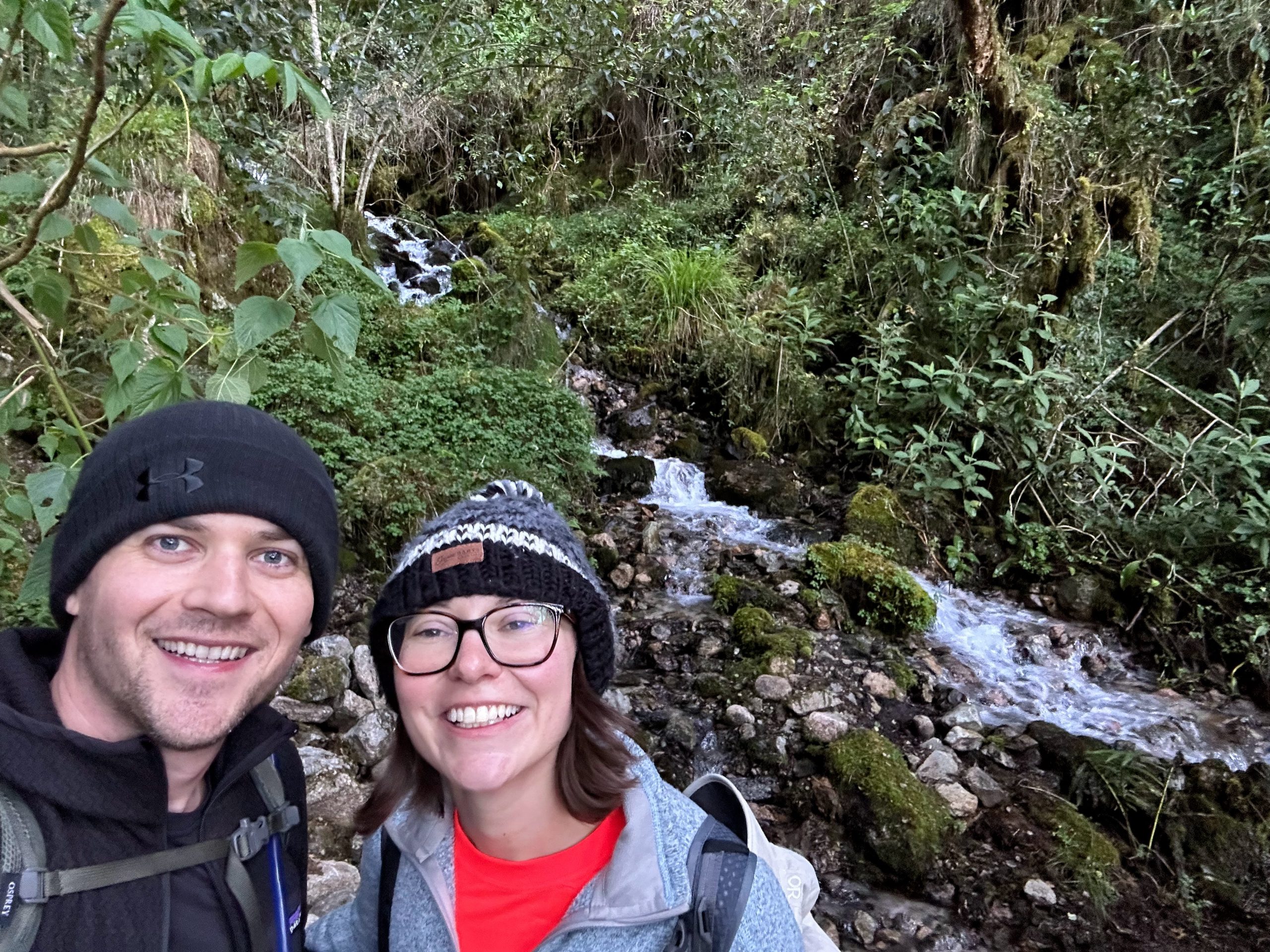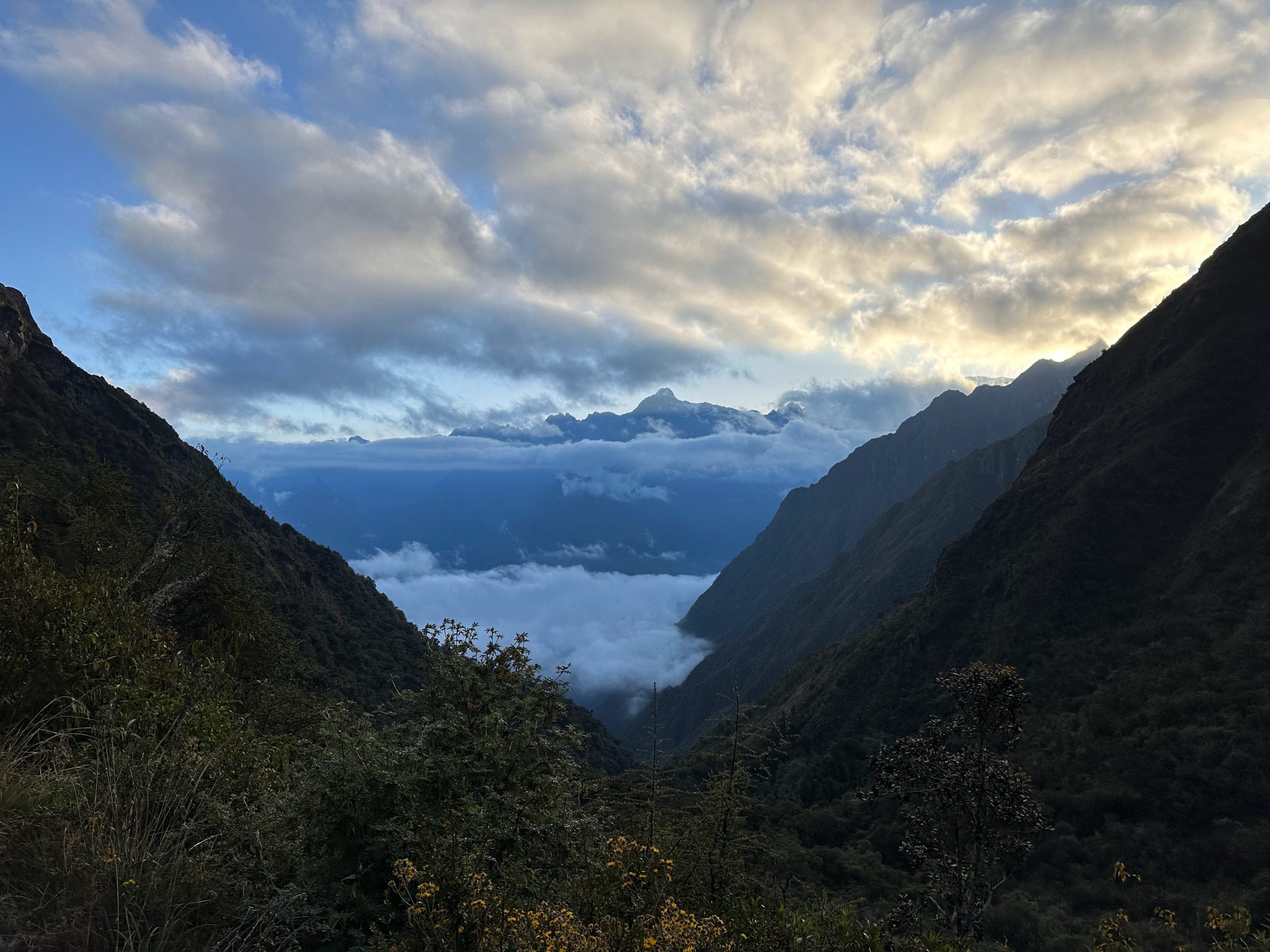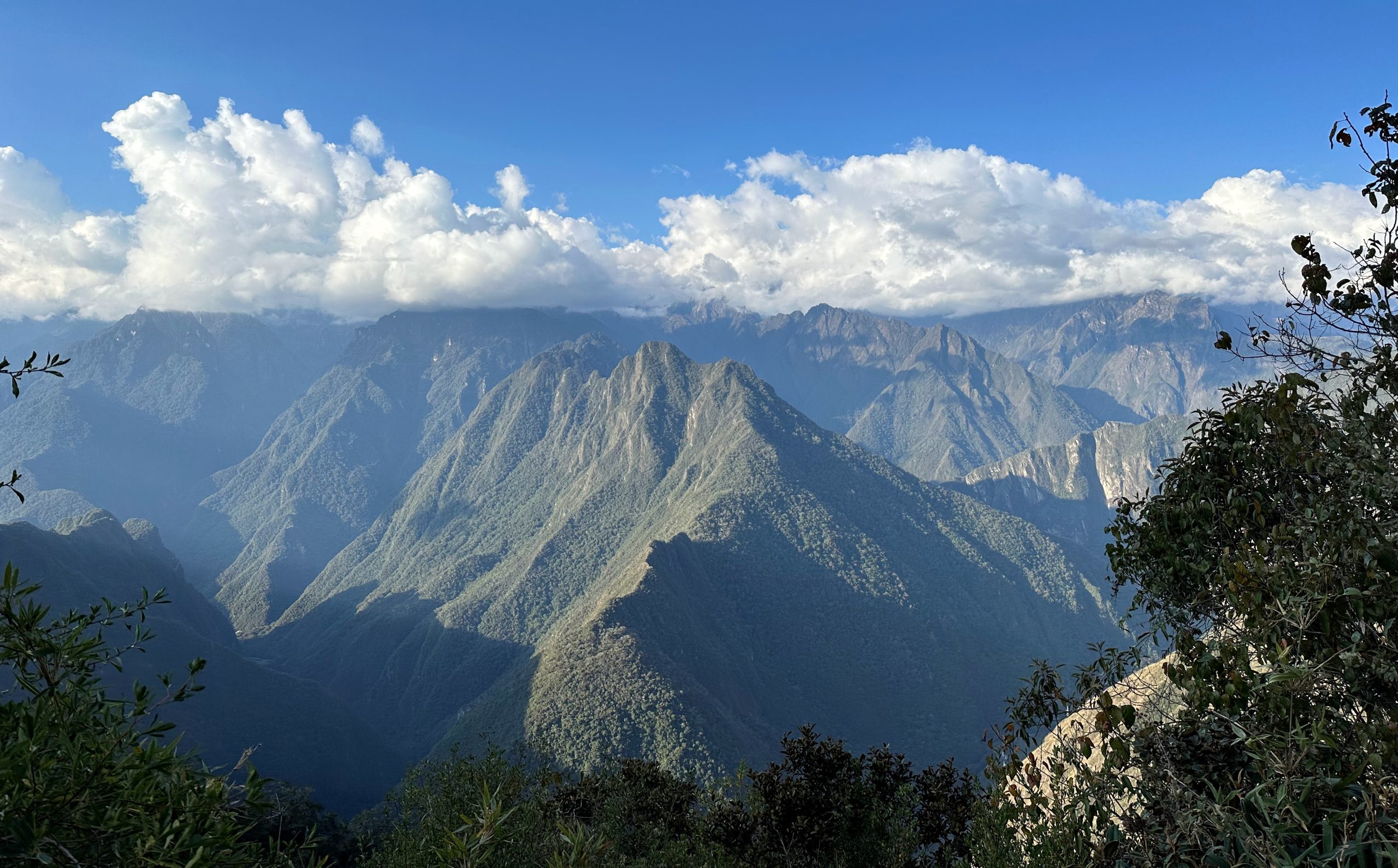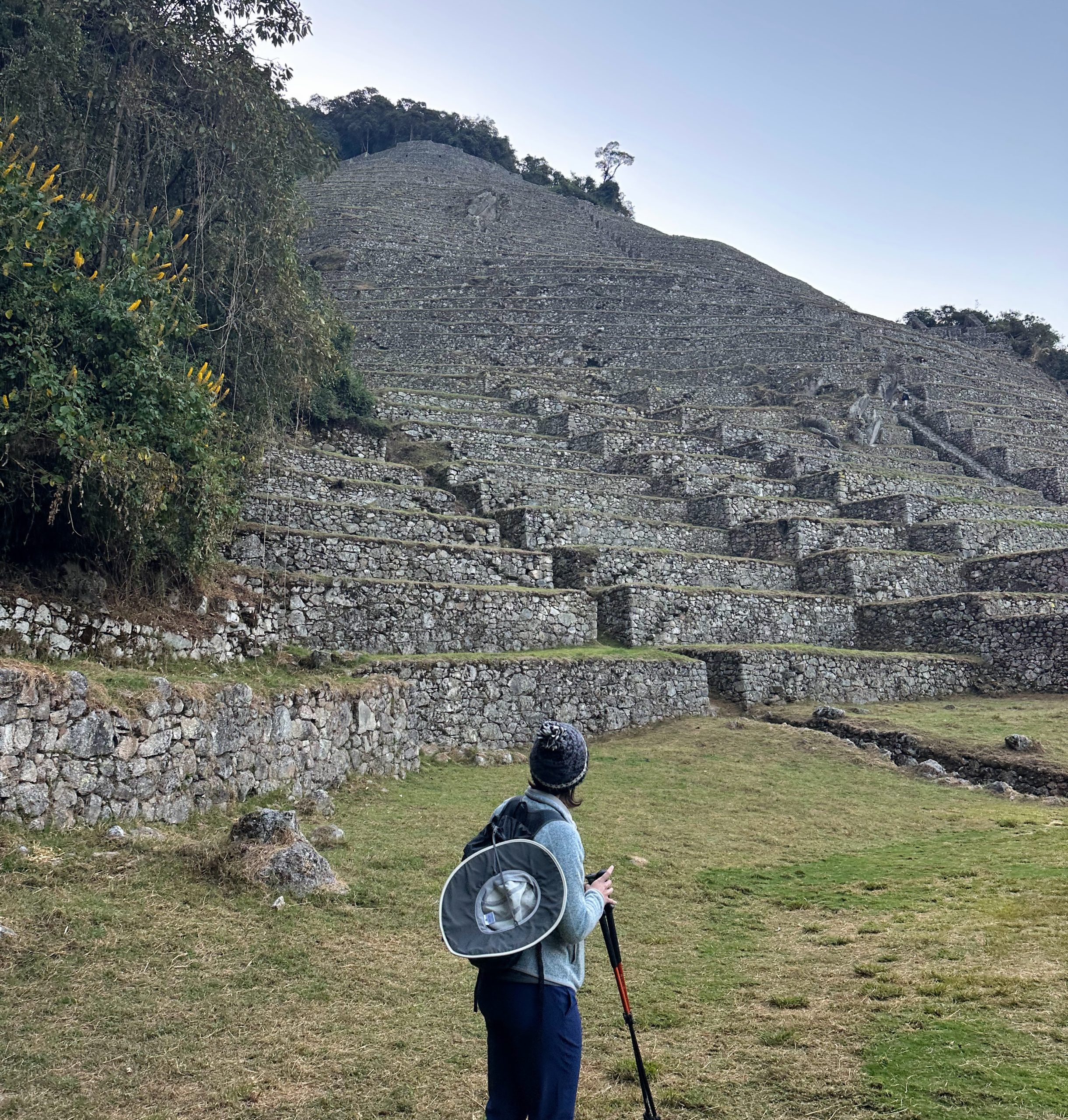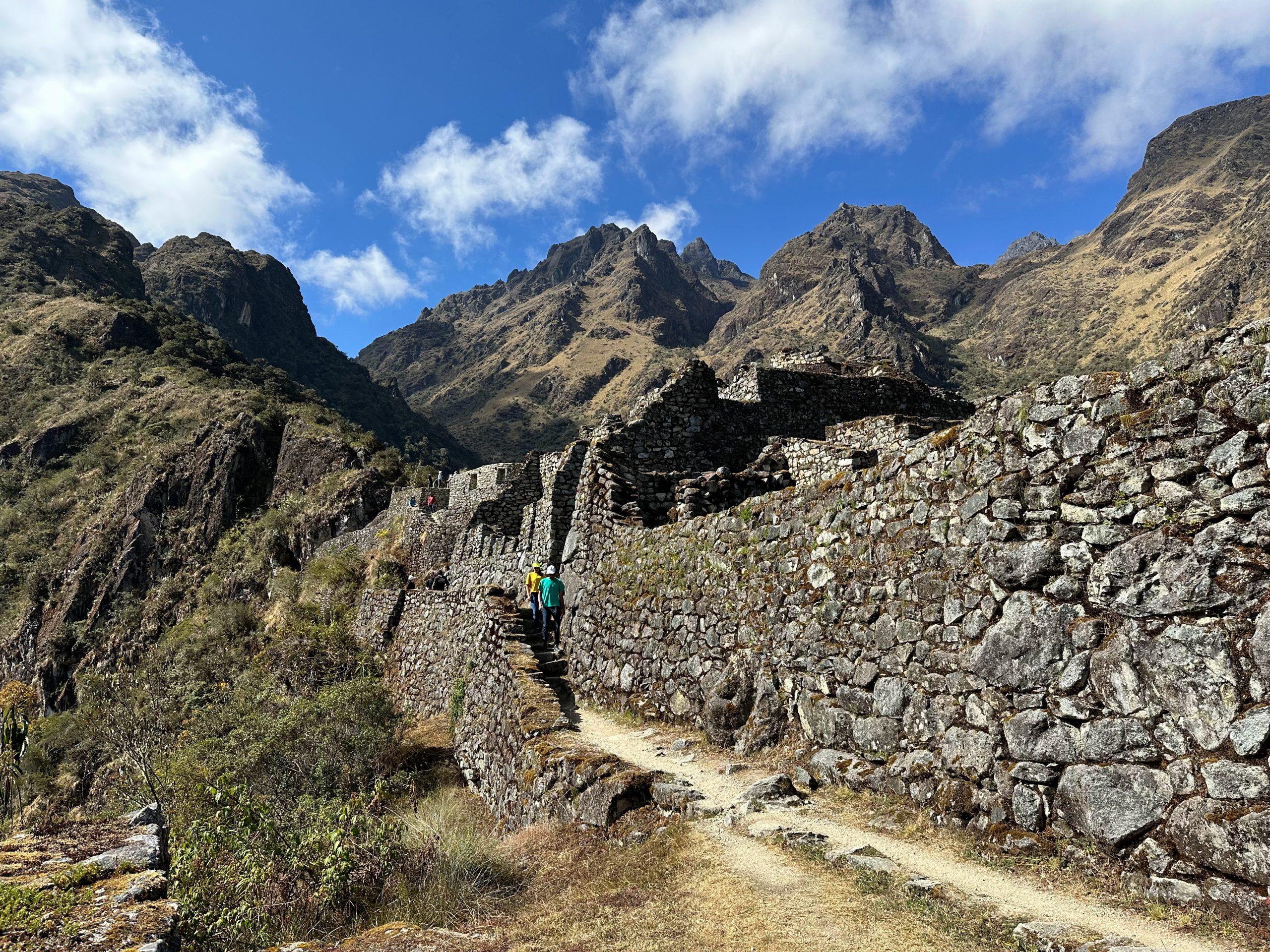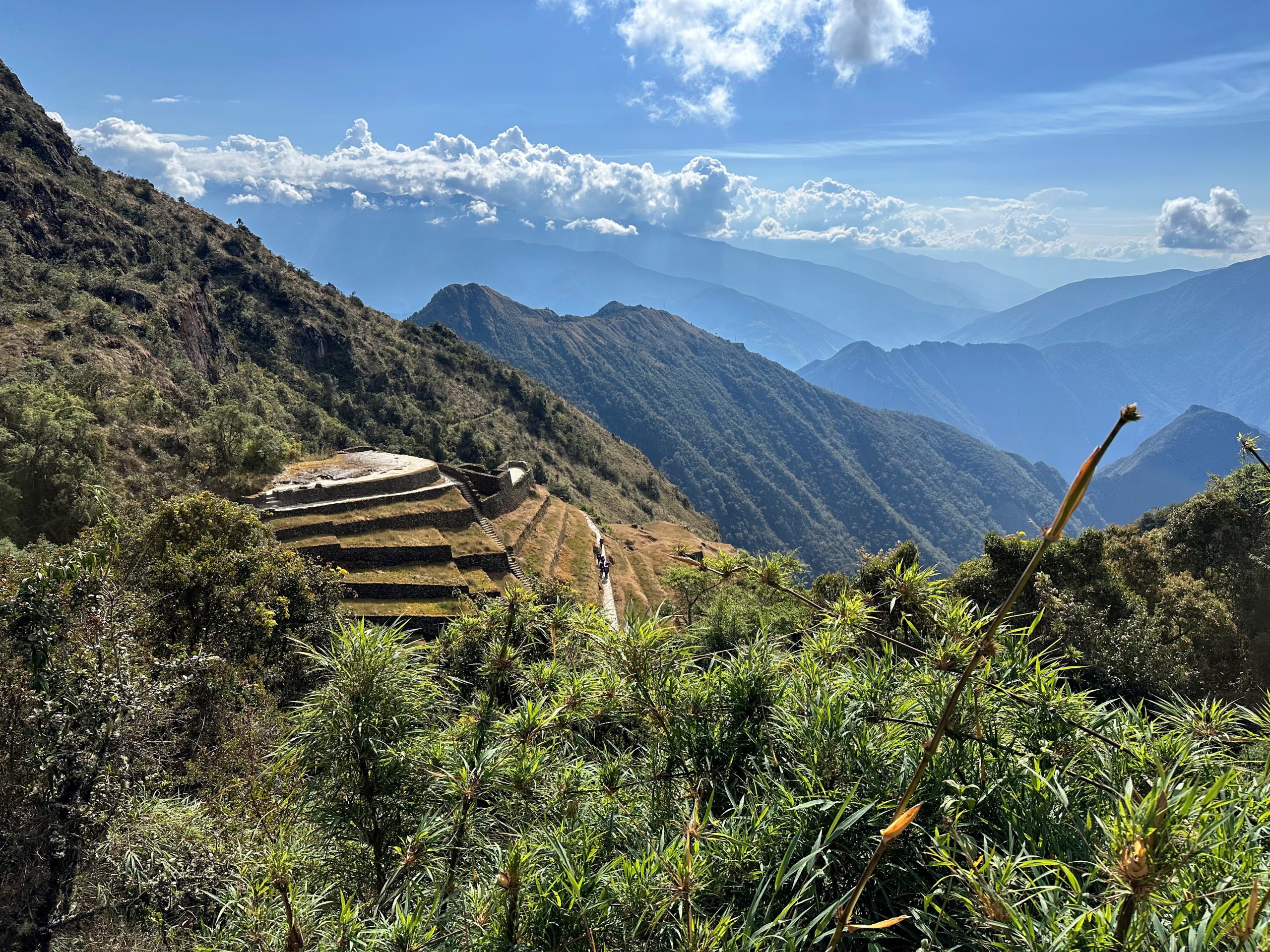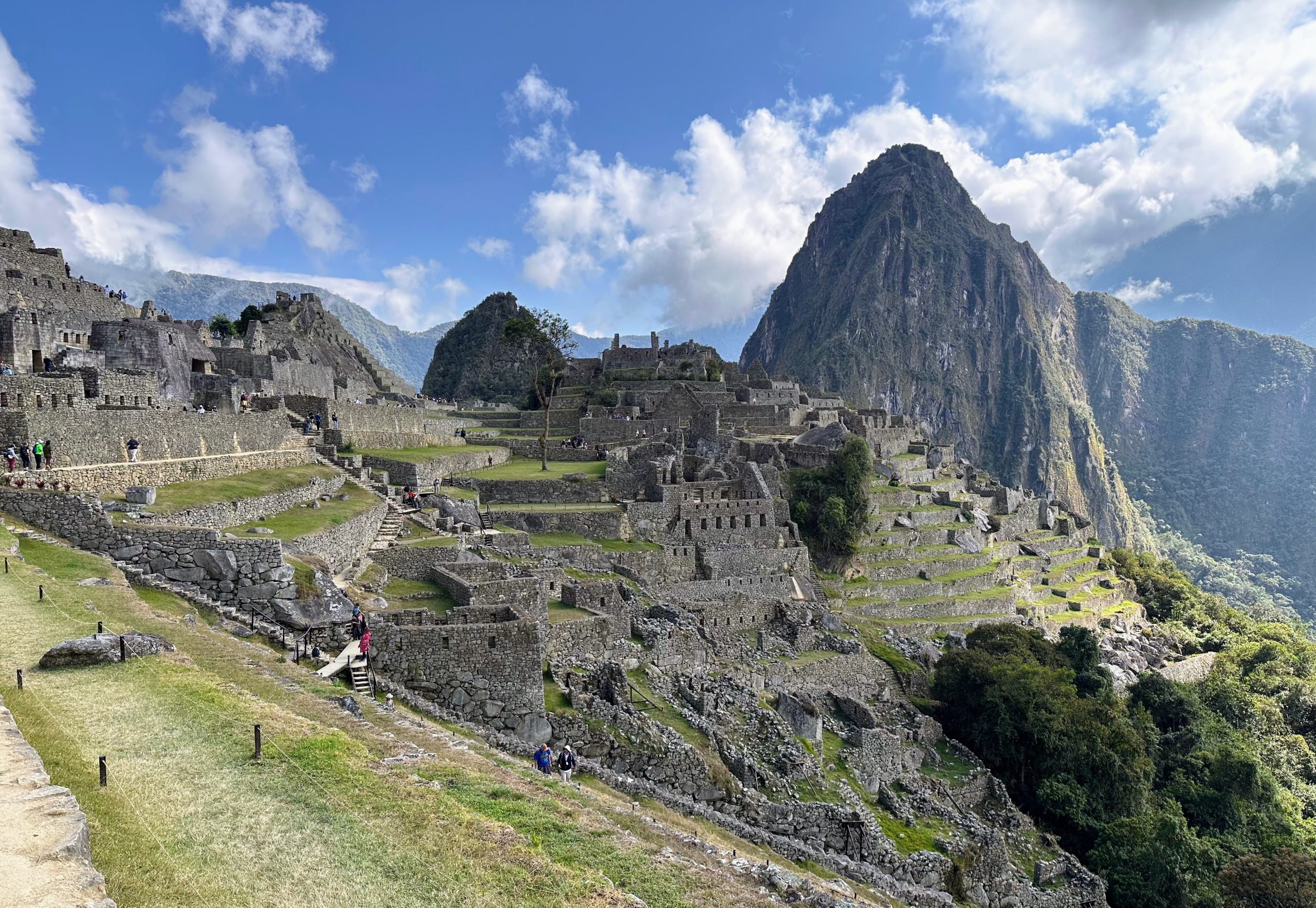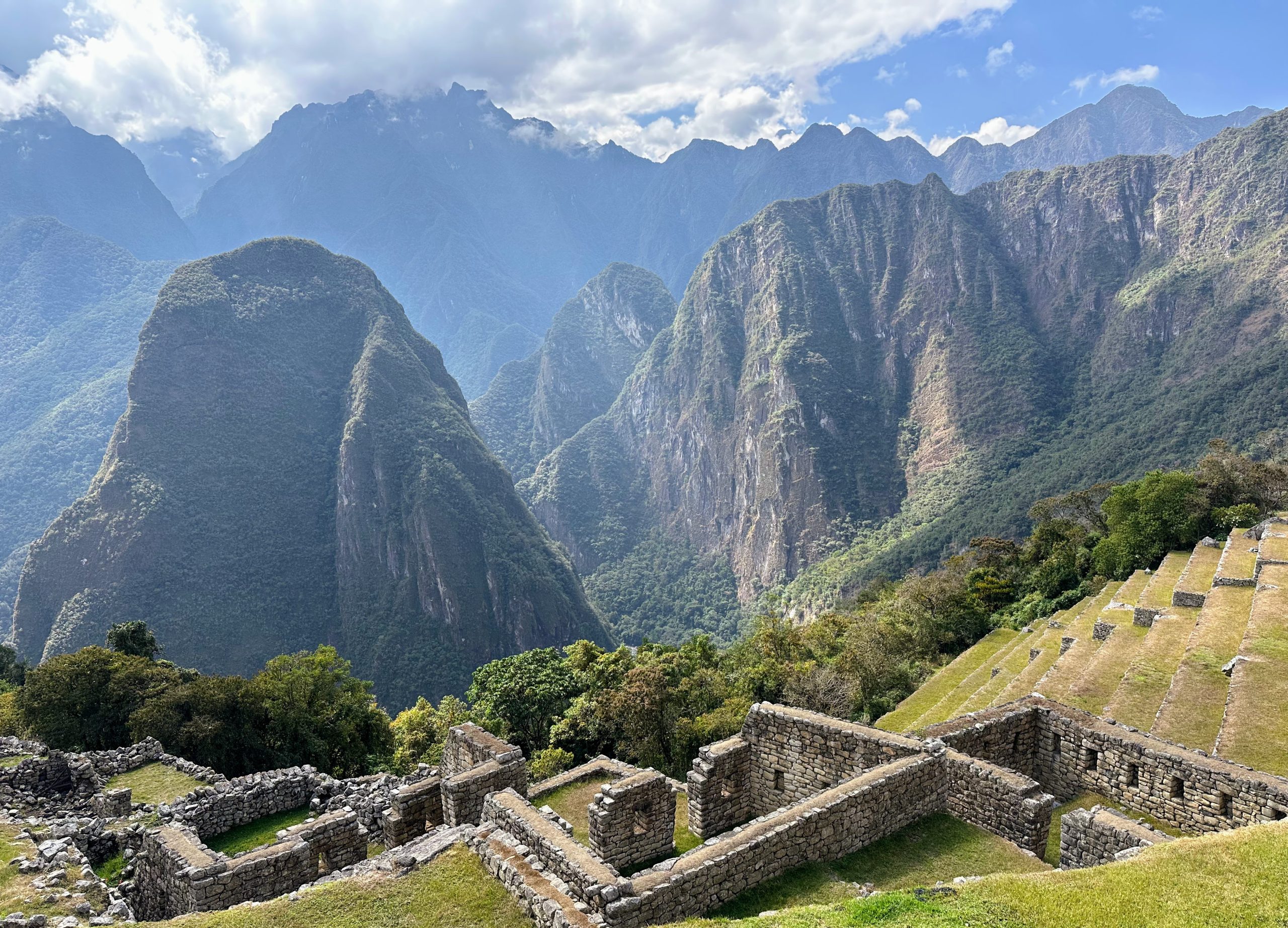Without a doubt, hiking the Inca Trail was one of our most memorable experiences to date. The views are incredible, the history is incredible – everything is incredible really. It is a challenging four days, but you will be left in awe of the Andes and the civilization the Incas built.
Everyone that hikes the Inca Trail must do so as part of a tour group. Given the historical significance of the region, Peru has taken steps to protect the land and ruins with a permitting system. Most tour groups generally follow the same path and schedule, but your experience may vary depending on the company you select. We went with G Adventures on the 4-day / 3-night hike and couldn’t be happier with our choice. This post details the specific itinerary we followed as well as other things to know about the experience.
Itinerary
Day 1
If you stay in Cusco prior to starting the Inca Trail, get ready for an early morning. Our bus from Cusco into the Sacred Valley left at 5:10 AM, which means we had to wake up around 4:00 AM to get our gear together and make our way to the tour office. Luckily the bus was comfortable enough to nap, but 4:00 AM is 4:00 AM. Our first stop was an outdoor pavilion near Urubamba for a quick, surprisingly good breakfast of fruit, eggs, potatoes, juices, and some other staples. From there we drove to Ollantaytambo, where we picked up some additional G Adventures travelers heading towards the trail. After that, it was on to Aguas Calientes for the start of the hike.
Once we arrived in Aguas Calientes, we spent some time getting our packs situated and enjoyed the last running toilets we would have for 3+ days. Our guide then walked us through the welcome center to provide a quick overview of the trail, its rules, and the wildlife we may encounter, and then we were on our way.
Overall, the hike the first day was pretty straight forward (7.5 miles total). Most of the trail is “Inca flat”, as our tour guide described it (i.e., rolling hills of gradual ascents and descents). The only real uphill section is at the end. That said, the ups and downs do add up throughout the day, and the end portion was more challenging than we expected, as it was our first real climb at altitude.
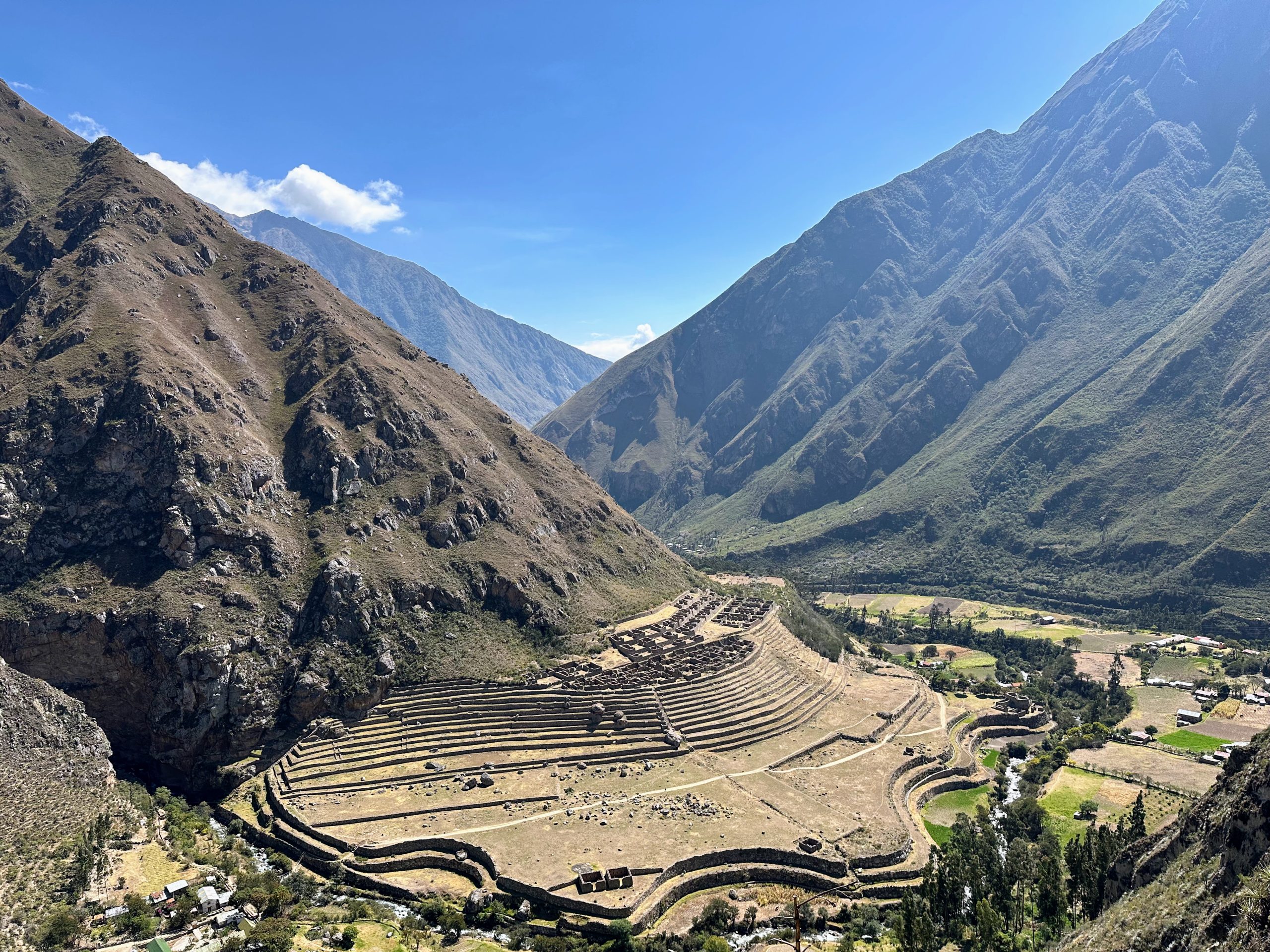
We got two see two Incan ruin sites this day – one close to the beginning of the trail, and one further away from above. These were really just an appetizer for the ruins we visited along the rest of the trail. Speaking of appetizers, about halfway through the hike we stopped for a four-course lunch (I know, right?) provided by our porters at a pop-up meal tent. Even without the huge meal, though (shout out to the guacamole and crackers), we wouldn’t have gone hungry on Day 1. There were plenty of locals along the trail selling drinks and snacks.
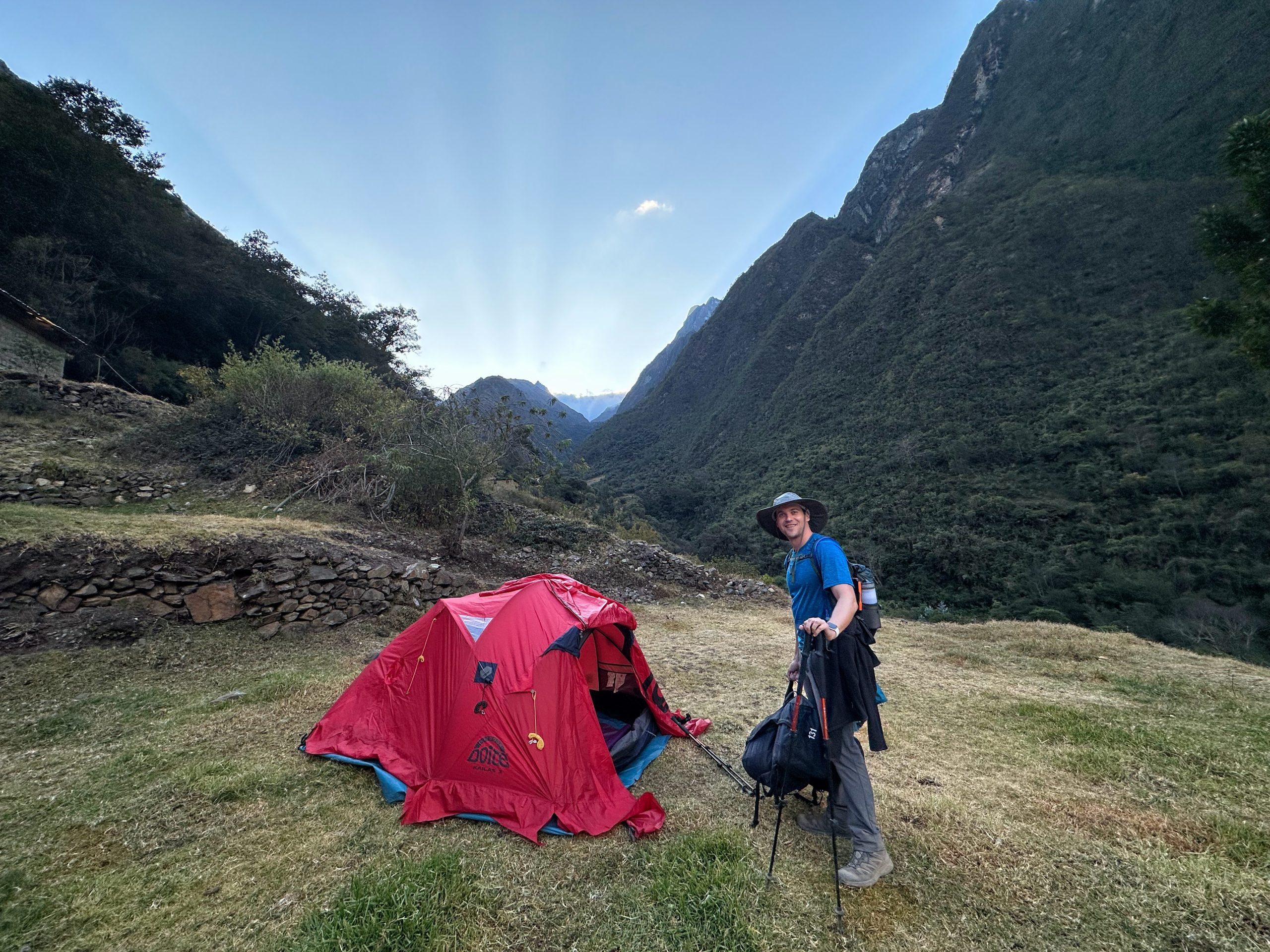
Our group of 12 had an individual camp site the first night outside a local’s home, and we made it there just before a happy hour of crackers, jam, tea, and hot chocolate. After that we got settled in our tents, enjoyed our first group dinner, and went to bed early to get ready for the next day’s hike.
Day 2
This was the hardest day of the hike. Over the course of 7.5 miles, we gained over 3,000 feet of elevation to a highpoint of nearly 14,000 feet above sea level. We really felt the altitude, but we got some incredible views.
Our day started at 5:00 AM. We spent the first half hour getting our gear packed up and cleaning ourselves off with an “Incan shower” (more on that below), followed by breakfast with our group at 5:30 AM in the meal tent. The breakfast was basic but delicious, with breads and spreads, instant coffee, various teas, and more hot chocolate.
We were on the trail by 6:30 AM, and the first 45-minute segment was easy enough. After that is where it got challenging. The second segment took about two hours and ended at a checkpoint with more snack vendors and toilet stalls. The third segment – all uphill and exposed to the sun – required many breaks. We got some quality time with our tour guide on this stretch since we were towards the back of the group. Once we finally made it to Dead Woman’s Pass (the highpoint of the trail), we spent 45 minutes there enjoying the views and eating some snacks.
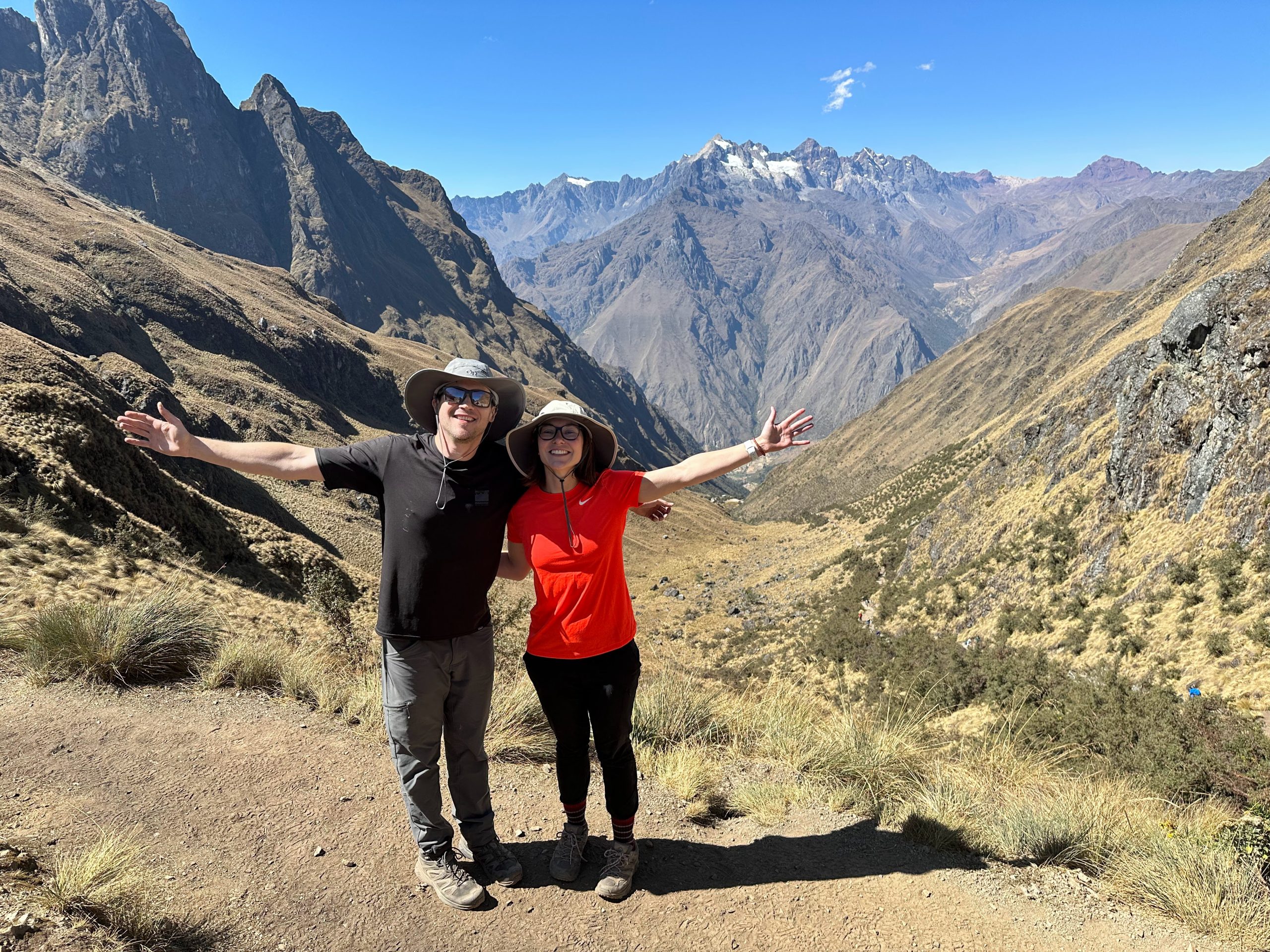
The last segment of the trail this day was all downhill to our campsite. We made it there around 2:00 PM for a late lunch – another four-course meal! After eating we had some time to relax, so we washed off in a (very cold) creek that was adjacent to the campsite, then watched a movie for a bit on our phone in the tent before dinner.
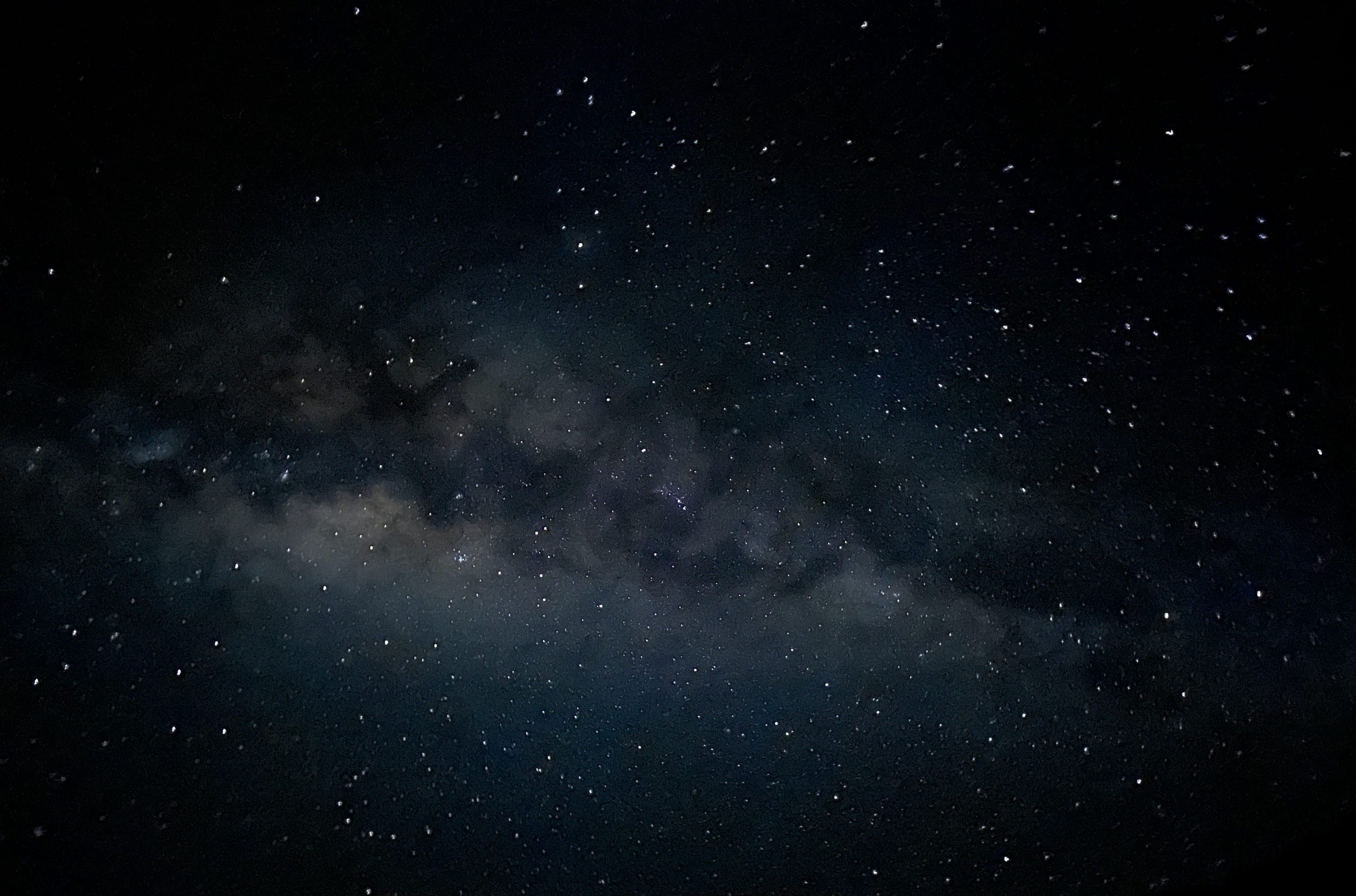
The food was great again, but the real highlight of this evening was the stargazing. This campsite was at a higher altitude than any other, so we had an amazing view of the Milky Way and night sky. After enjoying that for a bit we played some Uno with our hiking group and went to bed early; we had another early morning ahead of us.
Day 3
If Day 2 was the hardest day, then Day 3 was definitely the longest day (~10 miles total). We woke up once again around 5:00 AM to get ready, pack, and head to our 5:30 AM breakfast.
The trail on Day 3 was quite nice. It had steep moments, but it was at a lower altitude than Day 2 and not as challenging. We also had some incredible views and got to visit some really nice ruins. Because we were getting closer to Machu Picchu, we could see and appreciate how these sites were part of a network ultimately leading to the historic sanctuary. It’s still mindboggling how these fortresses were made on such inaccessible terrain.
If the ruins and scenery weren’t enough to make this day, we also met some llama friends! As we were nearing our final campsite, a herd walked right by us on the trail. We got very excited.

Our tour guides made a point to have us finish the trail together this day, so we made it to the campsite a bit later than usual (right before dinner – and they saved the best food for last). This campsite was huge and felt like an official base camp on the way to Machu Picchu. Strategically, it was just a short walk from the entrance to the permitted area so that everyone could make the sunrise hike to the Sun Gate.
Day 4
It’s the big day! Not even the 3:00 AM wakeup could get us down. We had to get an extra early start for a couple reasons: 1) our porters needed to pack our tents early so they could take a detour hike back to the bus stop, and 2) we had to get in line to enter the permitted area. The entrance doesn’t open until 5:00 AM, and it’s a race to get to the Sun Gate by sunrise. Because the trail is narrow here and doesn’t allow for passing, whoever you are behind in line to enter will also be in front of you the entire way to the Sun Gate.
The hike to the Sun Gate is easy and pretty short. You will need your headlamps for this section since it is before sunrise, but following the line keeps it simple. Unfortunately we didn’t have great weather this morning. There was light rain most of the way to the Sun Gate, and when we made it to the Sun Gate, this is what we saw:
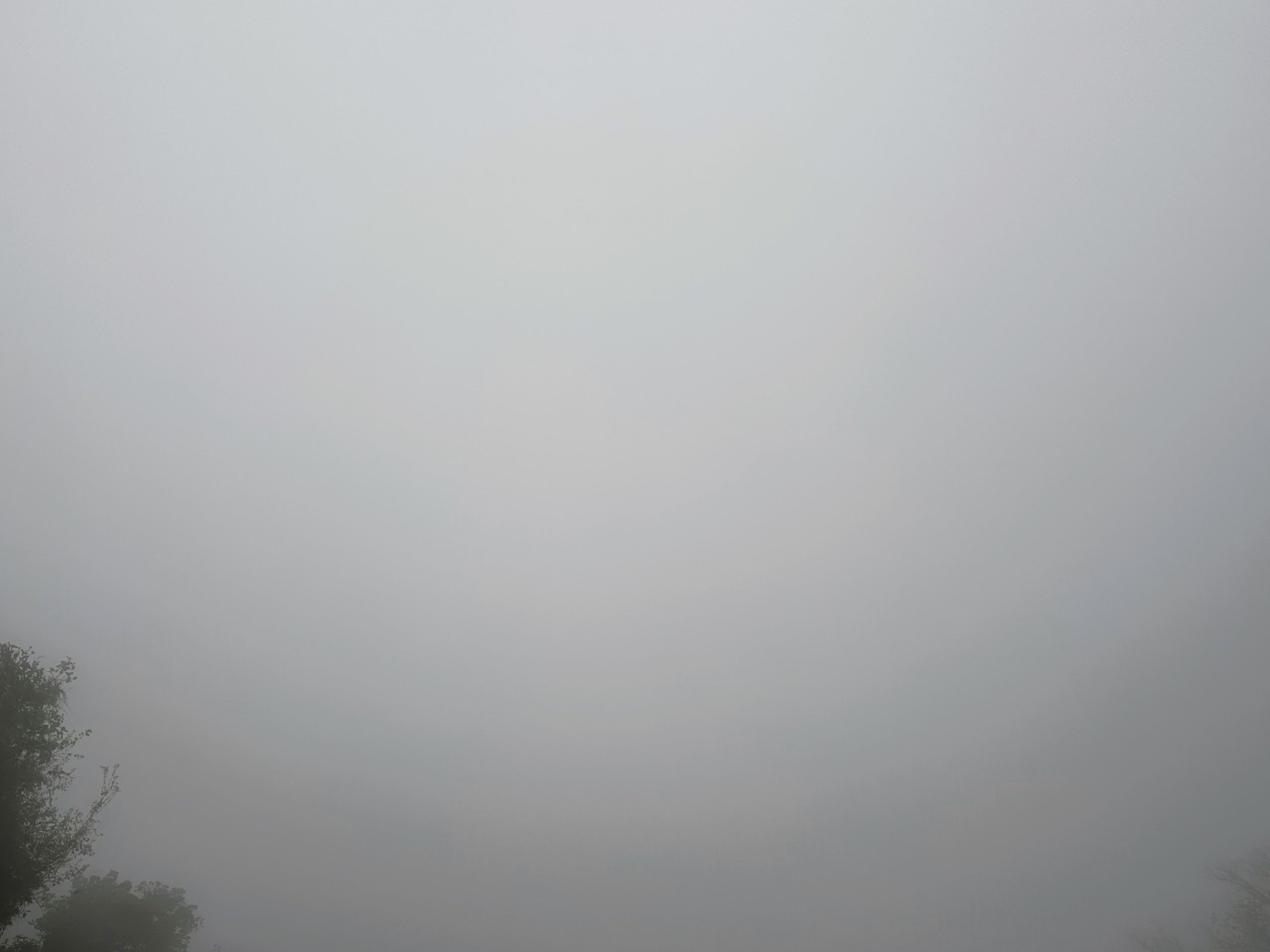
We sat around and waited at the Sun Gate for about 1.5 hours, but the fog just wouldn’t clear. After finishing some snacks, we decided to give up on the weather and head towards the Machu Picchu viewpoint.
Along this section of the trail, a magical thing happened – the sun poked through! After a quick stop for some coca leaves on our way to the viewpoint, we hustled to the end to take advantage of the weather. The crowds waiting for us there were nuts. In addition to everyone finishing up the Inca Trail, we had to contend with day trippers who skipped the hike and just came for Machu Picchu. Luckily, the viewing platforms had a dedicated section for hikers (probably to keep our smells away from the people wearing formal attire for a photo shoot). It took some time for the fog to fully dissipate, but once it did, we were greeted with some of our favorite views ever.
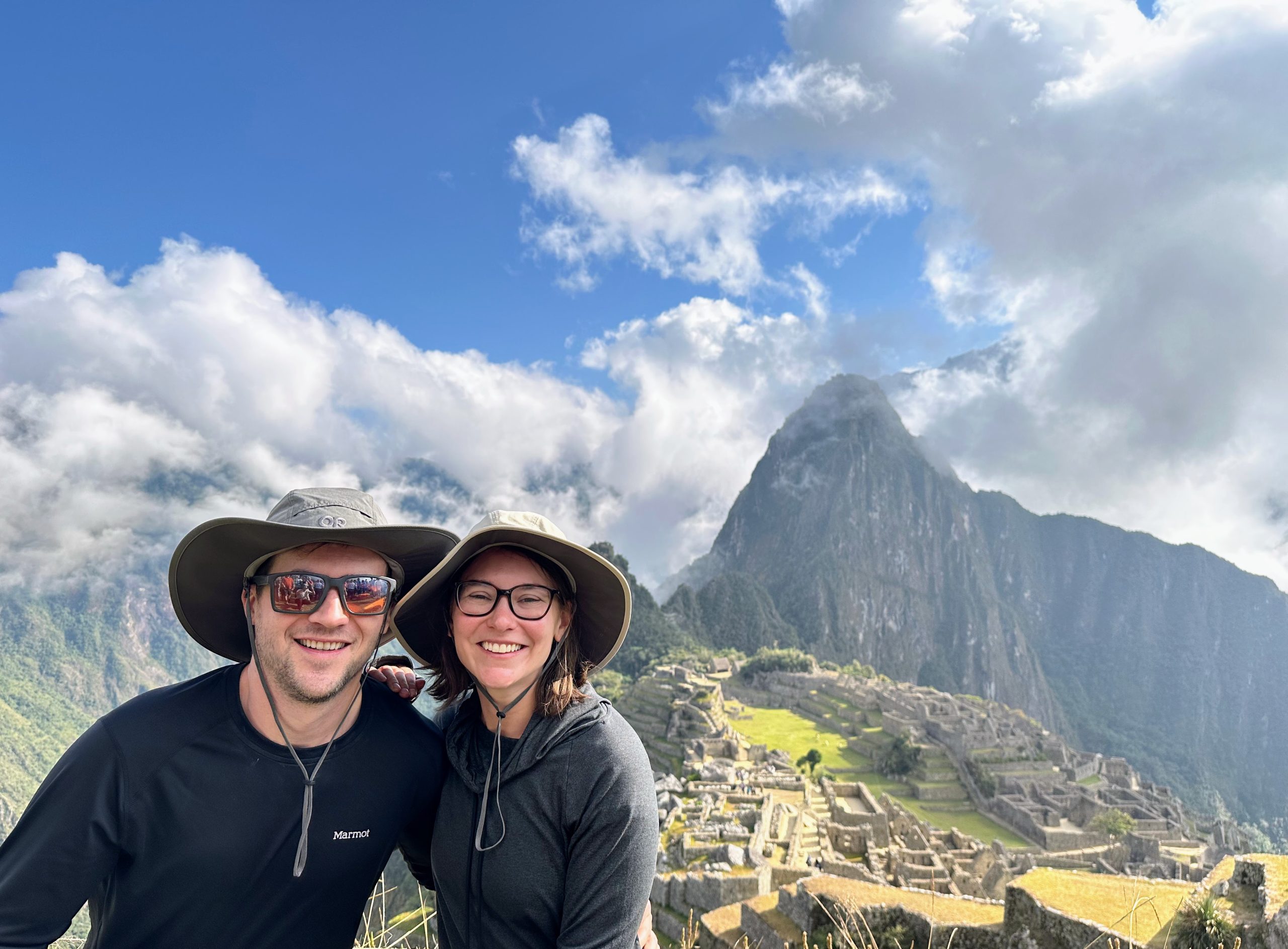
After probably 40 minutes of admiring the view and taking way too many photos, we left the viewing platform to take the short walk to the actual ruins of Machu Picchu. Once there we got to spend a couple hours hearing stories about the sanctuary, exploring the ruins, and marveling at the New Wonder of the World. Everyone was exhausted from the early wakeup and minimal sleep the night before, but it was still a completely memorable experience.
Leaving Machu Picchu was bittersweet. On one hand, it was a truly once-in-a-lifetime experience that we are so grateful we had. On the other hand, we got to use real bathrooms. Immediately outside of the ruins, there is a tourist center that includes paid restrooms, vending machines, and all the comforts you take for granted until you’re camping for a few nights in a row. We took full advantage until we boarded our bus to Aguas Calientes, where we had a group lunch at Munaycha Restaurant (everything here was solid – good opportunity to try alpaca meat). After lunch we took the train from Aguas Calientes to Ollantaytambo, then took another bus back to Cusco. The naps were flowing all around at this point, and it was wonderful.
Once we got back to Cusco, we were just done. We had these grand plans to go out to dinner and have some fun, but the hotel room was too comfortable and welcoming after camping the past few nights. Staying in the room, taking a long and necessary shower, and putting on a movie marked the perfect end to the hiking trip.
What to Pack
Pack light! Porters can generally carry 5 kg of your gear, which does not add up to much stuff. Anything over the 5 kg weight limit, you will need to carry yourself in your hiking backpack. We each brought an 18 liter collapsible backpack to carry our extra stuff, but in hindsight we wish we had brought bigger packs.
We opted to rent a sleeping bag and sleeping pad from our tour provider (these count towards your 5 kg weight limit!) so that we could avoid checking a bag on our flight to Peru. The gear provided is high quality, but it may be heavier than what you can find independently.
Apart from those two items, you will want to make sure you have the below in addition to your clothing:
- Water bottle or hydration bladder: Staying hydrated is especially important at altitude. In hindsight, we would have been okay with just our 3 liter hydration bladders because boiled water was provided whenever we stopped for lunch. However, we were also glad to have our filtration / purification bottle we could use at local taps
- Hiking poles: These are very helpful for inclines / declines and may be available for rent from your tour provider
- Bug spray: Your need for this will depend on the time of year, but we were glad we had it on Day 3
- Sunscreen, sun hat, and sunglasses: You will be very exposed on parts of the trail
- First aid kit: Band-aids, blister pads, and Neosporin will be lifesavers if you need them
- Hand sanitizer: It can get narsty out there
- Altitude sickness medicine: Many people in our tour group got a Diamox prescription proactively before the trip. We did not take this step, so we relied on Sorojchi pills that we bought in Cusco before the hike
- Headlamp: The campsites are very dark, and you will need the light for the early morning on Day 4
- Plastic bag: Packing out your waste is essential, so it is good to have a bag you can use during the day
- Bath wipes: We were happy we had these Sea to Summit wipes at the end of each day
- Camping pillow (if you want some extra comfort)
- Toiletry essentials: Please bring deodorant
- Kula cloth: This is a must for camping and hiking adventurers! It’s a reusable pee cloth that you can fold up and attach to your daypack. Toilet paper is not accessible at most toilet hole locations, and this is a great way to be more eco-friendly when using the bathroom.
- Power bank: You’ll want to make sure your phone / camera still has battery on Day 4!
As far as clothing goes, you will want to re-wear things as much as possible to conserve weight and space. This means packing one sleeping outfit for chilly nights / hanging out at the campsite and as minimal hiking clothes as possible. Depending on the season you are there, this could include a fleece and/or puffer jacket. Regardless of season, you will need rainwear. You will also want good hiking boots to protect your ankles and feet. If you (somehow) still have space after all that, it is nice to have slides or slippers to wear at the campsite.
The Camping Experience
We were in awe of our porters and the overall service provided by the tour group. First – about the porters. These guys, up to 60 years old, were each carrying 20+ kg of gear and completely smoking us on the trail. It was honestly unreal. We were huffing and puffing with every steep section as a result of the altitude, and these guys just kept on passing us with their massive bags. It would be more embarrassing if it wasn’t so impressive. Our group was given the opportunity to do the “porter challenge” and try carrying one of their 20+ kg bags … we respectfully declined. The two guys in our group that accepted the challenge did an admirable job but still didn’t make it that far.
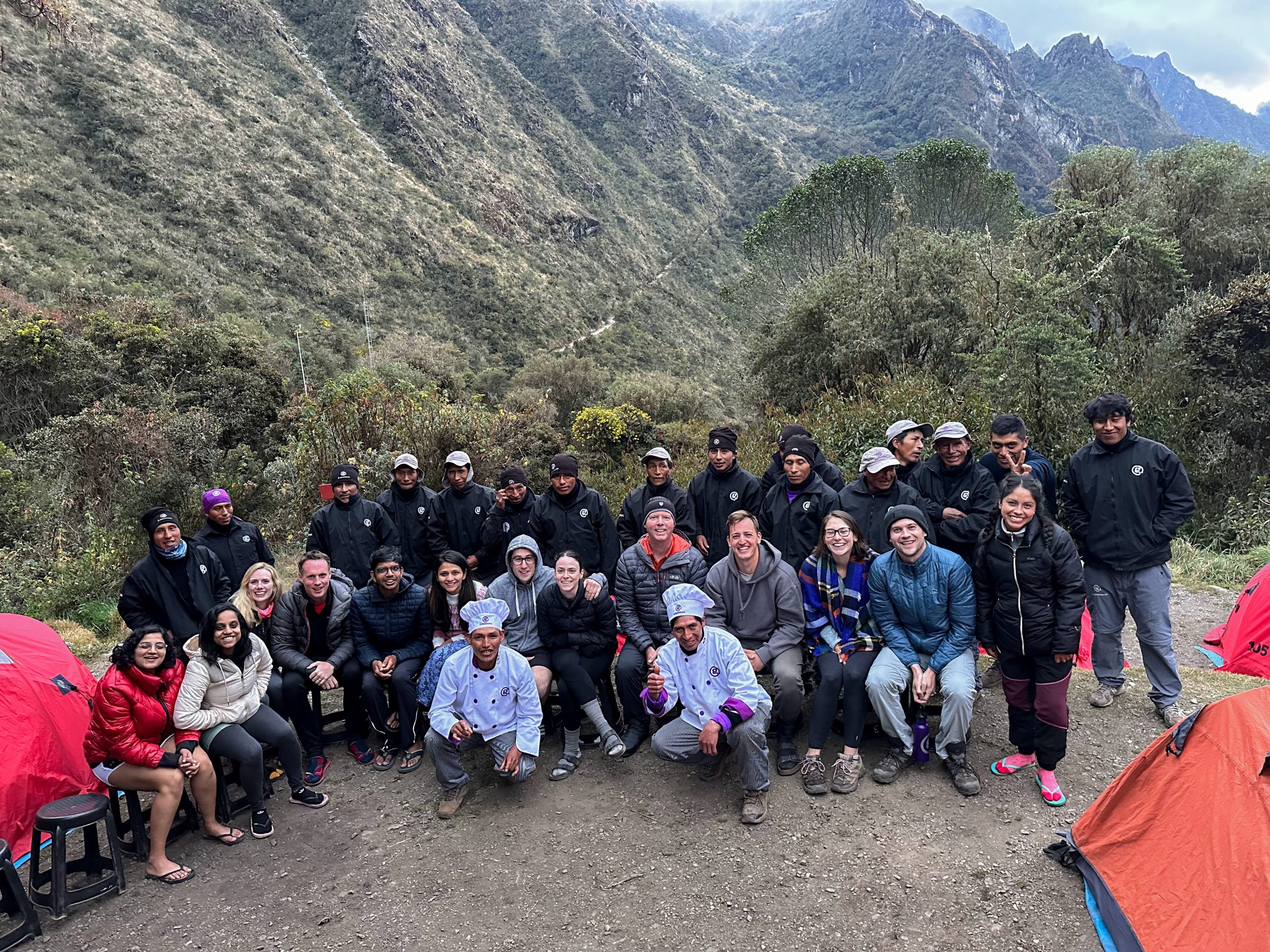
Because the porters were so much faster than us on the trail, they were able to provide a really comfortable camping experience considering the completely remote location. We’re talking pre-pitched tents every time we got to our campsite, four-course meals that should not be possible to prepare in the middle of nowhere when fires are not allowed, tea service and “Incan showers” (aka small tubs of warm water waiting outside our tents) each morning. They even baked us a cake over the course of two days! These guys literally lugged a generator up a mountain, and we cannot speak highly enough about how incredible they are.
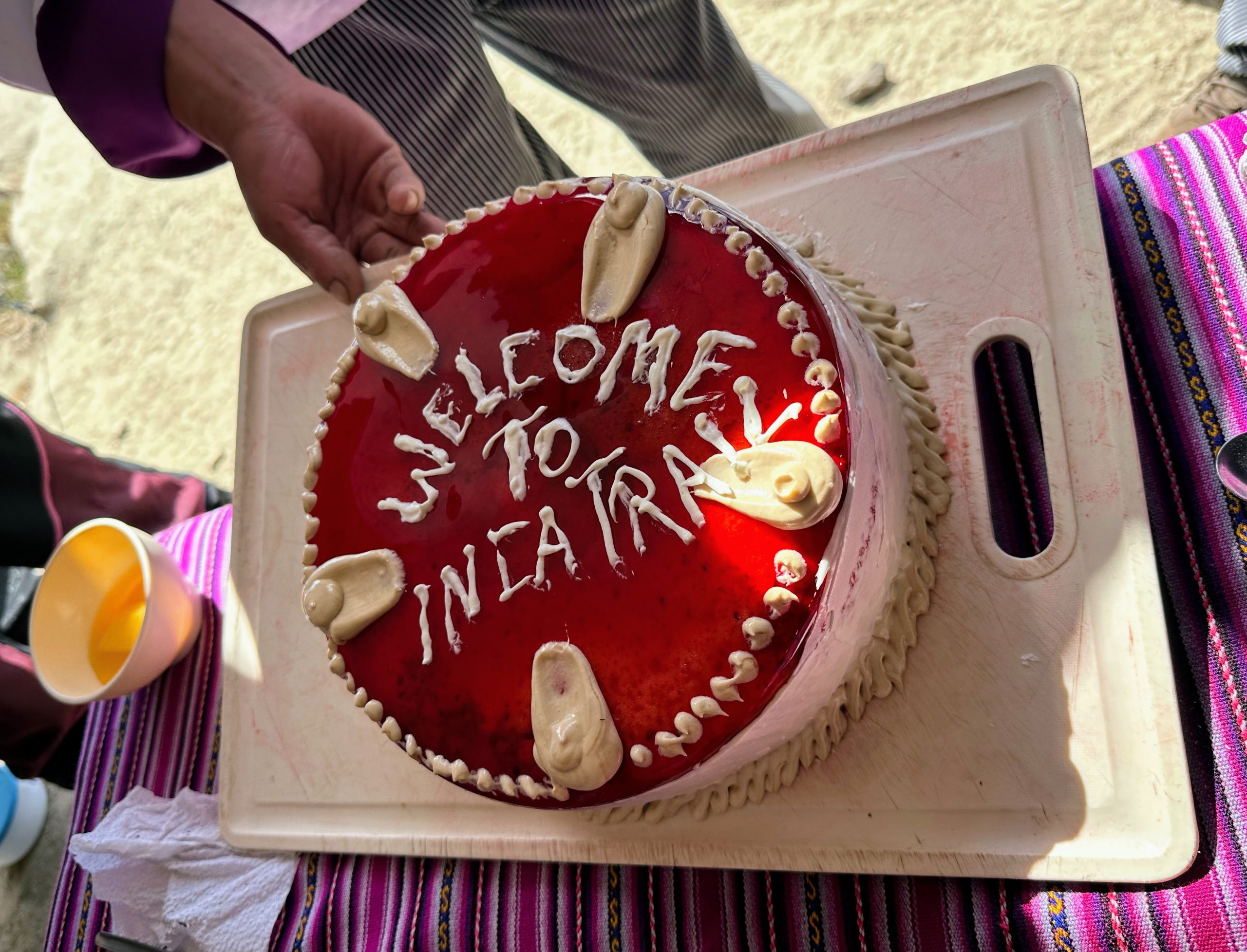
The tour guides as well were extremely knowledgeable, considerate, and just overall a joy to be around. We genuinely enjoyed our group meals in the dining tent that the porters set up each day, as we got to learn a lot about the trail, our guides’ experience in their roles, and Incan history. We really liked our hiking group too, which only added to the experience. There wasn’t much hanging out apart from these group meals and the actual hiking, as everyone was exhausted at the end of each day and eager to get to bed, but we thought it was a perfect balance.
With all that being said, it is still camping. There is no running water, no power, and no climate control. The tour provider did everything and then some to make sure we were as comfortable as possible in a location with zero infrastructure, but we were still staying in tents and using a toilet tent, which is exactly what it sounds like. We personally like camping and the escape it provides, but it definitely is not for everyone. If you are not the biggest fan of camping though, this is the time to make an exception. There is literally no other way to experience the Inca trail.
Other Tips & Tricks
- Bring cash for tipping: Your tour guides and porters rely on tips to make a living, and US Dollars go a long way in Peru. Bring local currency (Soles), tip generously, and treat them like the heroes they are.
- Train and acclimate: The hike itself is not too challenging, but it still requires a decent level of physical fitness. Take some time before your trip to warm up with some hikes or prepare your legs on the Stairmaster. It is also critical that you acclimate to the altitude before starting the hike. We recommend spending at least three full days in Cusco before getting started, as the altitude was easily the most challenging part of the experience.
- Visit during dry season: We visited Peru in July, and it was perfect. It got cold at night, but we would take that 10 times out of 10 over dealing with a bunch of rain on the trail.
- Use the toilet stalls as you pass them: There unfortunately are not many places to pull off the trail and relieve yourself. Take advantage whenever you come across a stall along the trail, and get hand sanitizer ready.
- Don’t drink too much before bed: Remember the toilet tents? You don’t want to need to visit those in the middle of the night. Drink plenty throughout the day, but moderate your intake in the evening.
- Treat yourself after the hike: We chose to stay at a nice hotel (Antigua Casona San Blas) after the hike – along with two other sets of people from our hiking group – and it was absolutely the right decision. Your body will welcome the comfortable bed, nice shower, and hospitality.
Happy traveling!
Kitrina & Jordan
